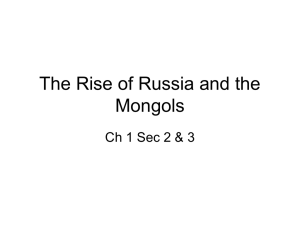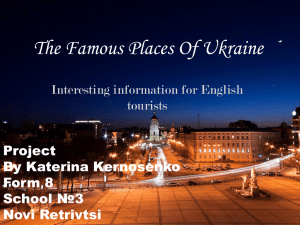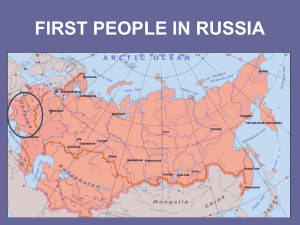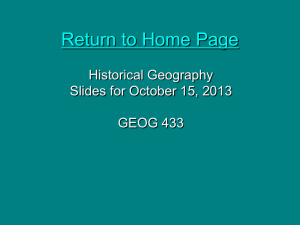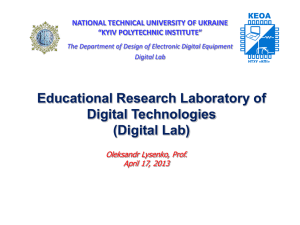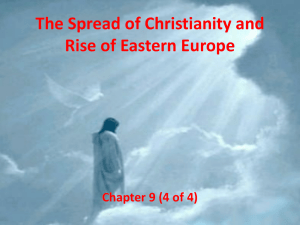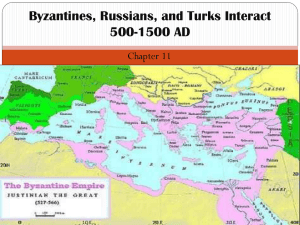Quantum transport simulation tool, supplied with GUI
advertisement
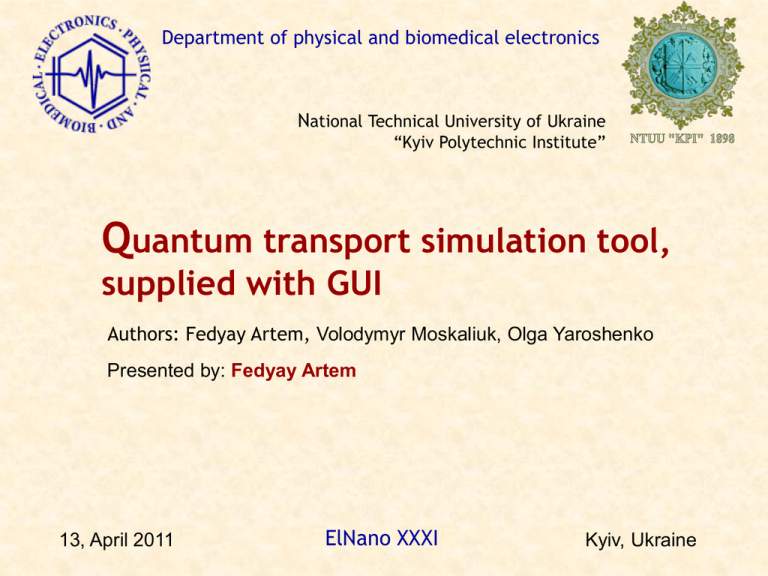
Department of physical and biomedical electronics National Technical University of Ukraine “Kyiv Polytechnic Institute” Quantum transport simulation tool, supplied with GUI Authors: Fedyay Artem, Volodymyr Moskaliuk, Olga Yaroshenko Presented by: Fedyay Artem 13, April 2011 ElNano XXXI Kyiv, Ukraine Overview Objects of simulation Physical model Computational methods Simulation tool Examples of simulation fedyay@phbme.ntu-kpi.kiev.ua 2 Objects to be simulated Layered structures with transverse electron transport: resonant-tunneling diodes (RTD) with 1, 2, 3, … barriers; Supperlattices Reference topology (example): fedyay@phbme.ntu-kpi.kiev.ua 3 Physical model. Intro ENVELOPE FUNCTION (EFFECTIVE MASS) METHOD Envelope of what? of the electron wave function: ψ(r ) u (r )χ(r ) nk χ(r )=e ikr in case of homogeneous s/c and flat bands (Bloch waves) What if not flat-band? fedyay@phbme.ntu-kpi.kiev.ua 4 Physical model. Type ENVELOPE FUNCTION (EFFECTIVE MASS) METHOD m1* ψ(r) χ(r) U (r) U (r) m m* 0 actual potential its approximation within the method m2* hereafter will denote envelope of the wave function of electron in a crystal fedyay@phbme.ntu-kpi.kiev.ua 5 Model’s restriction h/s with band wraps of type I (II) DEv Б Ev a A Ev a z Б DEv Б A Ec Ec DEc DEc Ez Ec DEv Band structures sketches Ez z Ev A a TYPE I TYPE II TYPE III GaAs – AlGaAs GaSb – AlSb GaAs – GaP InGaAs – InAlAs InGaAs – InP InP-Al0.48In0.52As InP-InSb BeTe–ZnSe GaInP-GaAsP Si-SiGe InAs-GaSb fedyay@phbme.ntu-kpi.kiev.ua DEc Ez 6 z Physical model. Type Sometimes referred to as “COMBINED” What do we combine? “ we combine semiclassical and quantum-mechanical ” approaches for different regions device (active region) left reservoir right reservoir ND ND b a с с i-AlxGa1-xAs b i-GaAs semiclassical (*) homogeneous , (**) almost equilibrium high-doped envelopefucntion n+-GaAs fedyay@phbme.ntu-kpi.kiev.ua (*) nanoscaled heterolayers , (**) non-equilibrium intrinsic 7 Physical model. Electron gas Parameter Value in l.r. Value in a.r. Value in r.r. Donor’s concentration ND=1022...1024 m-3 ND=0 ND=1022...1024 m-3 Material base n+ GaAs i-GaAs, i-AlAs n+ GaAs Electron gas (e.g.) 3D quazi-2D 3D State Dispersion low Local equilibrium E U (z) k k y2 k z2 Wave nature of electron is taking into account by means of Mean free path Motion mechanism Electron concentraion 2 2 2 k z2 k , * 2m 2m * Non-equilibrium 2 2 k z2 k , * 2m 2m * if k z 0(k z 0) E U ( z0(5) ) Effective mass; Band wrappings Less then reference dimentions Ballistic, quaziballistic Drift, diffusion nL( R ) Nc Ui 0 ( Ui 5 ) 2 Effective mass; Band wraping; Envelope wave function More then reference dimensions L( R ) (Ez (k z ), z ) Ez Ui 0( i 5) 2 Local equilibrium E U (z) 2 2 2 k z2 k * 2m 2m * Effective mass; Band wrappings More then reference dimensions Drift, diffusion E (EФ U1( N ) ) ln 1 exp z dEz , Nc kБT 2(m * )3/2 k БT (2)2 3 E Ui dE, Nc 4(2m * / h2 )3/2 E (EФ U1( N ) ) Ui 1 exp kT ni Nc fedyay@phbme.ntu-kpi.kiev.ua 8 Physical model. Master equations. (1 band) 1). Electronconcentrationinquantumregion: nL( R ) ( z,Uscf ) * 3/2 2(m ) kÁT (2)2 3 L (Ez (k z ),Uscf ( z, nL( R ) ) Ui 0 (Ui 5 ) Ez Ui 0( i 5) 2 E (EÔ U1( N ) ) ln 1 exp z dEz , k T Á where U ( z, n( z )) Ulattice ( z ) Uscf ( z, n( z)) 2). Poissonequation : dU d 1 ( z ) scf n( z,Uscf ( z )) N ( z ). dz dz 0 Wave functions are solutionsof Schrodinger equations d 1 d L( R ) ( z ) 2m * (E U ( z )) L( R ) ( z ) 0 2 dz m * ( z ) dz fedyay@phbme.ntu-kpi.kiev.ua 9 Physical model. Electrical current. Coherent component Coherent component of current flow is well described by Tsu-Esaki formulation: 2m*ekBT J ez (2 )2 3 T (Ez ) is a transmission coefficient through T (Ez )D(Ez )dEz ,where max(Ui 5 ,Ui 0 ) E z (EB U1 ) 1 exp k T Á D(E z ) ln E z (EF UN ) 1 ex p k T B quantumregion fedyay@phbme.ntu-kpi.kiev.ua 10 Physical model. Electrical current. (!) Coherent component EFR UN T (E z ) depends on EF electron states from both reservoirs Ez U i5 U (z ) EF electron states from left reservoir EFL Ui0 0 z0 z5 no electron states L quantum region fedyay@phbme.ntu-kpi.kiev.ua 11 z Physical model. Y? We need |YL|2 and |YR |2 for calculation of CURRENT and CONCENTRAION Which equation YL and YR are eigenfunction of? – Schrödinger equation with effective mass. Hˆ E , where Hˆ Tˆ Ec ( z ) UH ( z ) iWop , where: 2 1 is kinetic energy operator; 2 z m *( z ) z Ec ( z ) is a bottom of Г-valley; UH is the Hartree potential; Wop is so-called “optical” potential, which is modeling escaping of electrons from coherent channel due to interaction with optical phonons. Tˆ fedyay@phbme.ntu-kpi.kiev.ua 12 2-band model. What for? 0.6 DE L XL EAlAs GaAs L EGaAs L 0.2 0 AlAs X X EGaAs 0.4 GaAs DE 0.8 AlAs X EAlAs GaAs DE X E, эВ b a 0 b a a+b fedyay@phbme.ntu-kpi.kiev.ua z 13 2-band model. What for? E, эВ 0.8 Г-X-Г Г-X 0.6 ! [100] 0.4 X Г-X-Г 0.2 0 Г-X mixing points Current re-distribution between valleys changing of a total current Electrons re-distribution changing potential fedyay@phbme.ntu-kpi.kiev.ua 14 Physical model. YГ, YX? It was derived from k.p-method that instead of eff.m.Schr.eq. it must be a following system: Uà UH E z ( x ) i 2 1 ( xi ) à 2 z mà z U X UH E z X 0 à 0 2 1 X 2 z m X z 0 which “turns on” Г-X mixing at heterointerfaces (points zi) by means of . It of course reduces to 2 independent eff.m.Shcr.eqs. for X and Г-valley fedyay@phbme.ntu-kpi.kiev.ua 15 Physical model. Boundary conditions for Schr. eq. We have to formulate boundary conditions for Schrödinger equation. They are quite natural (QuantumTransmissionBoundaryMethod). Wave functions in the reservoirs are plane waves. eikz ikz rL e t R e ikz t L eik z e ik z ik z rR e z L R k T (E z ) tL k 2 Transmission coefficient needs to be found for current calculation fedyay@phbme.ntu-kpi.kiev.ua 16 Physical model. Features Combined quazi-1D. Self-consistent (Hartee approach). Feasibility of 1 or 2-valley approach. Scattering due to POP and Г-X mixing is taking into acount. fedyay@phbme.ntu-kpi.kiev.ua 17 Scientific content circumstantial evidence: direct use of works on modeling of nanostructures 1971-2010 1. Moskaliuk V., Timofeev V., Fedyay A. Simulation of transverse electron transport in resonant tunneling diode // Abstracts Proceedings of 33nd International Spring 2. Seminar on Electronics Technology “ISSE 2010. Abramov I.I.; Goncharenko I.A.; Kolomejtseva N.V.; Shilov A.A. RTD Investigations using Two-Band Models of Wave Function Formalism // Microwave & Telecommunication Technolog, CriMiCo 2007. 17th International Crimean Conference (10–14 Sept. 2007), 2007.–P.: 589–590. 3. Абрамов И.И., Гончаренко И.А. Численная комбинированная модель резонансно-туннельного диода // Физика и техника полупроводников. - С. 1138-1145. 4. Pinaud O. Transient simulation of resonant-tunneling diode // J. Appl. Phys. – 2002. – Vol. 92, No. 4. – P. 1987–1994. 5. Sun J.P Mains R.K., Haddad G.I. “Resonant tunneling diodes: models and properties”, Proc. of IEEE, vol. 86, pp. 641-661, 1998. 6. Sun J.P. Haddad G.I. Self-consistent scattering calculation of Resonant Tunneling Diode Characteristics // VLSI design. – 1998. – Vol. 6, P. 83–86. 7. Васько Ф.Т. Электронные состояния и оптические переходы в полупроводниковых гетероструктурах. – К.: Наукова Думка, 1993. – 181 с. 8. Zohta Y., Tanamoto T. Improved optical model for resonant tunneling diode // J.. Appl. Phys. – 1993. – Vol. 74, No. 11. – P. 6996–6998. 2005. – Вып. 39. 9. Mizuta H., Tanoue T. The physics and application of resonant tunnelling diode. – Cambridge University Press, 1993. – 245 c. 10. Sun J.P., Mains R.K., Yang K., Haddad G.I. A self-consistent model of Г-X mixing in GaAs/AlAs/GaAs quantum well using quantum transmitting boundary method // J. Appl. Phys. – 1993. – Vol. 74, No. 8. – P. 5053–5060. 11. R. Lake and S. Datta. Nonequilibrium “Green’s function method applied to double barrier resonant tunneling diodes”, Phys. Review B, vol. 45, pp. 6670-6685, 1992. 12. Lent C. S. and Kirkner D. J. The quantum transmitting boundary method // Journal of Applied Physics. - 1990. - Vol. 67. - P. 6353–6359. 13. K.L. Jensen and F.A. Buot. “Effects of spacer layers on the Wigner function simulation of resonant tunneling diodes”, J. Appl. Phys., vol. 65, pp. 5248-8061, 1989. 14. Liu H.C. Resonant tunneling through single layer heterostructure // Appl. Phys. Letters – 1987. – Vol. 51, No. 13. – P. 1019–1021. 15. Пакет для моделювання поперечного транспорту в наноструктурах WinGreen http://www.fz-juelich.de/ibn/mbe/software.html 16. Хокни Р., Иствуд Дж. Численное моделирование методом частиц: Пер. с англ. – М.: Мир, 1987. – 640 с. 17. Нгуен Ван Хьюеу. Основы метода вторичного квантования. – М.: Энергоатомиздат, 1984. – 208 с. 18. R. Tsu and L. Esaki. “Tunneling in a finite superlattice”, Appl. Phys. Letters, vol. 22, pp. 562–564, 1973. 19. Самарский А.А. Введение в теорию разностных схем. – М.: «Наука», 1971. – 553 с. fedyay@phbme.ntu-kpi.kiev.ua 18 Computational methods Numerical problems and solutions: ? Computation of concentration n(z) needs integration of stiff function ? Schrodinger equation have to be represented as finite-difference scheme, assuring conservation, and needs prompt solution ? using of conservative FD schemes and integrointerpolating Tikhonov-Samarskiy method; Algorithm of self-consistence with good convergence should be used to find VH ? using adaptive Simpson algorithm; using linearizing Gummel’s method Efficient method for FD scheme with 5-diagonal matrix solution (appeared in 2-band model, corresponding to Schrödinger equation) direct methods, using sparse matrix concept in Matlab (allowing significant memory economy) fedyay@phbme.ntu-kpi.kiev.ua 19 Let’s try to simulate Al0.33Ga0.64As/GaAs RTD L=100 nm device left.r. right.r. ND=1024 ND=1024 3 nm 10 nm i-Al0.33Ga0.67As 4 nm 3 nm 20 nm i-GaAs fedyay@phbme.ntu-kpi.kiev.ua n+-GaAs 20 Application with GUI fedyay@phbme.ntu-kpi.kiev.ua 21 Emitter fedyay@phbme.ntu-kpi.kiev.ua 22 Quantum region fedyay@phbme.ntu-kpi.kiev.ua 23 Base fedyay@phbme.ntu-kpi.kiev.ua 24 Materials data-base (1-valley case) (!) Each layer supplied with the following parameters: mГ(x), x – molar rate in AlxGa1-xAs mГ(x)=m00+km*x, DEc(x) – band off-set DEc(x)=U00*x (x) is dielectric permittivity (x)= e00+ke*x fedyay@phbme.ntu-kpi.kiev.ua 25 Settings fedyay@phbme.ntu-kpi.kiev.ua 26 Graphs fedyay@phbme.ntu-kpi.kiev.ua 27 Calculation: in progress (few sec for nsc case) fedyay@phbme.ntu-kpi.kiev.ua 28 Calculation complete fedyay@phbme.ntu-kpi.kiev.ua 29 Concentration fedyay@phbme.ntu-kpi.kiev.ua 30 Potential (self-consistent) fedyay@phbme.ntu-kpi.kiev.ua 31 Concentration (self-consistent) fedyay@phbme.ntu-kpi.kiev.ua 32 Transmission probability (self-consistent) fedyay@phbme.ntu-kpi.kiev.ua 33 Local density of states g (Ez,z) (self-consistent) fedyay@phbme.ntu-kpi.kiev.ua 34 Local density of states (in new window with legend) fedyay@phbme.ntu-kpi.kiev.ua g (Ez,z) 35 Distribution function (tone gradation) fedyay@phbme.ntu-kpi.kiev.ua N (Ez,z) 36 I-V characteristic (non self-consistent case) fedyay@phbme.ntu-kpi.kiev.ua 37 Resonant tunneling diode (2 valley approach) (!) Each layer supplied with additional parameters: mX DEХ-Г CB in Г and X-points fedyay@phbme.ntu-kpi.kiev.ua 38 LDOS in Г and X-valleys Г-valley X-valley: barriers wells fedyay@phbme.ntu-kpi.kiev.ua 39 Transmission coefficient 2 valleys Г – valley only (*) Fano resonances (**) additional channel of current both Г and X valleys fedyay@phbme.ntu-kpi.kiev.ua 40 Another example: supperlattice AlAs/GaAs 100 layers CB profile LDOS fedyay@phbme.ntu-kpi.kiev.ua 41 Try it for educational purposes! Simulation tool corresponding to 1-band model w/o scattering will be available soon at: www.phbme.ntu-kpi.kiev.ua/~fedyay (!) Open source Matlab + theory + help Today you can order it by e-mail: fedyay@phbme.ntu-kpi.kiev.ua 2-band model contains unpublished results and will not be submitted heretofore THANK YOU FOR YOUR ATTENTION fedyay@phbme.ntu-kpi.kiev.ua 42

